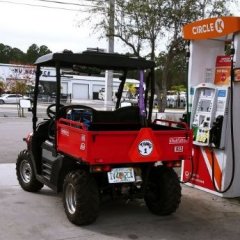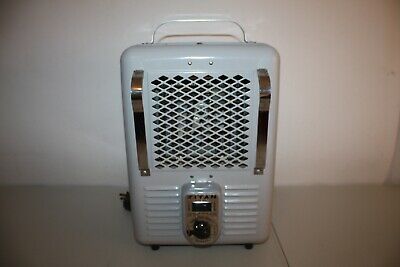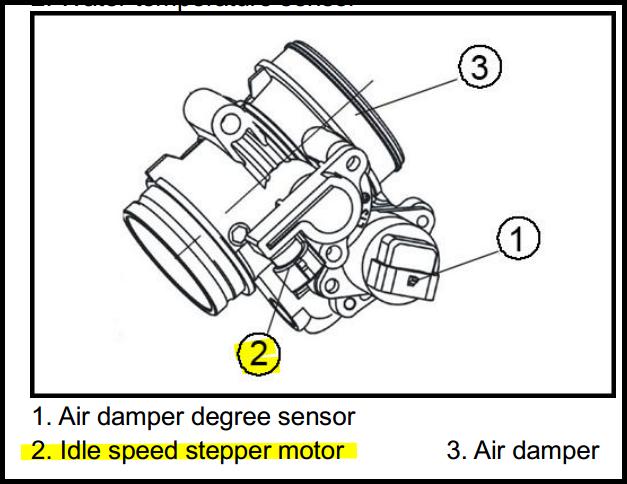-
Posts
350 -
Joined
-
Last visited
-
Days Won
49
Content Type
Profiles
Events
Forums
Gallery
Downloads
Community Map
Everything posted by cliffyk
-
Were I installing a plow (not likely as I am in Saint Augustine, FL) I would go with the strap--they have a bit more stretch (which will make it much resistant to dynamic loading) , but as you are only using 6" to 8" of it it doesn't matter. A strap will also spread contact with the fairlead (roller or Hawes) out over a much larger area, greatly reducing wear.
-
I was researching winching and hoisting safety factors and ran across this very good All About Winch Cable tutorial--thought I'd share it here. It is very sobering to find your 4700 lb winch cable has a SWL (Safe Working Load) limit of just 940 lbs, applying a 5:1 safety factor (generally applied for hoisting). At 3:1, a typical winching/pulling safety factor it's still only safe to 1566 lbs. And, that 9000 lb (max) snatch block you just bought--SWL = 3000 lbs. 9000 lbs. is the load at which it will break and fly back and kill you. That's why one of my first mods for my Outfitter 400 was a wireless remote winch controller; when you start pulling really hard it is best to be as far away as you can...
-
My bottom line, honest opinion of synthetic v steel line in this application--given the absurd geometry of the jury-rigged "hoist" configurations on most (maybe all?) ATV/UTV snowplows--it is that it's a "six of one and a half-dozen of the other" situation. The application violates 50% or more of either product's engineering guidelines. Either will fail "prematurely" from a consumer perspective. I am a mechanical engineer (MSME MIT '71) and the first time i saw one of these things I cringed, more surprised that it worked at all than by the very short service lives we see reported. All that said were i setting up my own I'd most likely go with the wire rope and keep it well lubricated with an extreme-pressure penetrating lubricant such as Penetro 90.
-
I would not recommend synthetic rope for most of the snowplow configurations I have seen. UHMW polyethylene (the material used to make synthetic winch rope) is very strong and has very low stretch--these normally desirable characteristics make it somewhat unsuitable for the high dynamic (impact) loads presented by a plow, and the torture path through which the cable/rope passes on most plows--this is especially true if the fairlead through which they pass has a small radius--as do most UTV winch configurations. For 12-strand 3/16" rope UHMW rope makers typically specify minimum pulley diameters of 2.5 to 3.0"--anything smaller and they downgrade the rope's breaking strength by 50%. Steel cable does not stand up well in the typical UTV plow hoist application--those where the cable simply exits the fairlead and connects to the plow at a 75° to 90° angle--synthetic rope stands up less well . Another issue is that in a plow hoist application the stress and strain are applied repeatedly to just a very small segment of the rope's overall length, usually just 6" to 8". Best would be a UHMW poly strap or a 3" to 4" pulley for the rope to pass over...
-

How is idle adjustment done? Hisun 700 UTV 2015 EFİ Models
cliffyk replied to ANIL SEDALI's topic in UTV General Discussion
Modern EFI systems do not generally have adjustable idle settings in the classic sense--I.e. some mechanical adjustment as with carbureted engines--instead the idle speed is controlled by the electronic engine management system. Most often this a accomplished via an idle air control (IAC , Hisun seems to call it an "idle speed stepper motor") valve operated by a stepper motor or duty-factor controlled spring-loaded solenoid valve that controls the amount of intake air allowed to bypass the throttle body main damper ("butterfly"). IAC valves are usually mounted on the throttle body. The idle speed setting is accomplished by reprogramming the engine management system--not by turning a screw or manipulating some other mechanical device IAC mounted on the throttle body (this is from the service manual for my HS400): Hisun EMS schematic: Components: Idle too high = too much air passing through the IAC valve or leaking into the intake tract between the throttle body and the intake port on the cylinder head.. This can happen if the IAC valve sticks or otherwise cannot operate freely--or-- if air is leaking into the intake manifold "after" the throttle body. Check that he intake gaskets, tubes, etc. are tight; If you feel competent to do so remove the throttle body and make sure the IAC operates freely. -
Hello all, I just recently added a dual port USB charger outlet to my Hisun HS400 and thought others might be interested in same: Got it from Amazon for $13.49. The HS400 has a couple of plugged holes in the dash, left over from prior versions that had the ignition and lighting switches in the dash (these are on the steering column on my 2020 model). The adapter mounts in a 28.5 mm hole so I hogged out the obsolete lighting switch hole (25 mm) with a Dremel tool fitted with a 1/2" sanding drum. I wired it to a permanent power source as it draws very little power (< 5 μA) when not in use--at 5 μAit would take 1.6 million hours (182 years) to drain the battery down to 10 V . It has it's own power switch. The unit delivered 4.55 V @ 3.0 A with the engine off (12.6 V input) which meets USB specs. The voltmeter displays the system voltage with surprising accuracy-- that's a good value to monitor to reveal battery and/or charging system problems. I like it... the embossed legend is an artifact of the old lighting switch being here
-
You should contact the previous owner and see if they have it cluttering up their garage--if you don't need a hitch it's just another thing to rattle, that's why I took it off. Mine sat, covered with a rag, on a stool in the corner of my barn for nearly 3 months 'til I just recently (in part prompted by your post) got the ambition to do something with it...
-
They know it's wrong, but don't seem to care. As vendors love to say, it is a "nominal" 1-1/4" square (nominal as in "That's what we call it."). My Coleman Outfitter 400 (Hisun HS400) came with the same 1.713"square receiver as the OP's machine, however it also came with a 6" or so long, 1-1/4" "adapter"--problem was that the adapter 's inner dimensions were 1.245" x 1.24"--I.e. Without a hydraulic press and a torch there's no way a 1-1/4" draw bar would go in that hole. Anyway, I got an email announcing that a Coleman rep would be at the store (our local Tractor Supply) just before Christmas; and being a glutton for punishment made the trip into town to discuss this issue. I had quite a go-round with the "factory rep"; he removed the "adapter" from a UT400 they had on display and using his "reference tool" (a well-worn retractable 16' steel tape) proceeded to show me how it was indeed 1-1/4" square inside. So I trotted my butt into the store, grabbed a 1-1/4" draw bar off the rack, brought it out, gave it to him, and said "You mount the damned thing then!" He failed of course and then declared the draw bar "oversized"--again using his precision 16' tape. Seeing this was going nowhere I retreated to my barn and attempted to use my 1/2" x 18" belt sander to hog out the adapter (It only needs 0.030" more I told myself)--well three 60 grit belts later I had managed to make it at least square (1.245" x 1.245") and decided to go with plan "B", got out a 6" disc grinder and bastardized a 1-1/4" draw bar to fit the adapter. That worked; some photos; plan "A", the adapter and my 1/2" x 18" belt sander: plan "B", the bastardized draw bar (not my finest work, but give me a break, I've got Parkinsons--my neurologist says it's a wonder I can do this sort of thing at all): mounted on the beast: This of course means that this is my draw bar unless I bastardize another, but it places a ball at 14" from the ground and just took an hour or so grind down..
-
Hello all, In looking for a synthetic line for my Outfitter 400's 3500 lb. Runva winch I ran across this offering from Harbor Freight; $30.99 with 20% off coupon + tax = $26.40--not too bad (please spare me the "Cheap Chinese junk" yowls, where do you think 99.44% of the components of, and stuff we buy, for our toys comes from?). It is made of UHMW polyester with a claimed (and fully believable) tensile strength of 4700 lbs. and a working load of 3000 lbs.--which is in keeping with the specs published by most manufacturers of UHMW rope and therefore much more believable than the 6000 and absurd 8200 lb. claims made by other vendors. It comes with a G70 snap-hook (sized for 1/4" chain), and an anodized aluminum Hawes type fairlead. The package I bought did not contain the red strap shown in HF's ad, which based on reviews is a common failing of the kit. Also, there is no snubber provided, I got a nice one of silicone rubber with stainless fasteners from Amazon for $7. The winch and business ends of the rope are sleeved with black urethane coated nylon (were i to guess) protective sleeves-for 8+ ft at the winch end and 5 ft. or so at he hook end. The winch end has a couple inches of heat shrink tubing to prevent unravelling and assist in fastening it to the typical bore-through/set screw winch drum. The 12-strand braided rope appears to be of a high quality UHMW polyester, as claimed, the fairlead is cleanly cast and appears to have been glass bead or shot blasted after casting a it has a smooth fine pebble grain finish. The mounting holes are at the standard 124 mm (4-7/8") center-to-center distance as is common on ATV and UTV winches. All 50' installed easily on my winch, the 8 ft or so of protective sleeve providing a nice supporting first wrap. The sleeve at the business end completely covers the last layer of rope, providing a nice shield to protect the synthetic rope from prolonged UV exposure. Likewise, the fairlead bolted right up with no problem. on the drum: the Hawes fairlead and snubber: long shot: It is important to keep in mind when using synthetic winch rope that, while it is very strong, it is also very low stretch, typically just 3.5% at break--in practice this can result in dynamic shock loading exceeding it's tensile strength. This is also true of steel wire rope, but the metallic rope can better handle dynamic loading. I also would not recommend synthetic rope for use in that torture track that is common to winch hoisted low-cost ATV/UTV snowplows. The mechanical dis-advantage which most plow designs operate and apply to the winch hoist is staggering. In such plows am less surprised that the rope (synthetic or wire) breaks than that it survives more than one use. I like it... [update 02/04/2021] After some experimentation using a digital scale, a 55 lb. anvil and both the roller and Hawes fairleads I have re-installed the roller fairlead. I found that at extreme fleet angles (45° to 90°--angles you should try to avoid) the Hawes fairlead increased required cable load by 10% to 25% vs. the roller fairlead. One caution however; make certain there is sufficient overlap of the roller faces and the ends of their companion rollers--both ways. On my roller fairlead the rollers overlap the ends of their 90° opposed companion by 1/2 their diameter as illustrated below: roller orientation, my fairlead--top view: roller orientation, my fairlead--side view: I have seen roller guides in which this was not the case which allows the much more flexible synthetic line to "fall off" the active roller and jam between the end of its companion roller and the fairlead frame--which would of course be bad. While I had it apart I also stitched and whipped the protective sleeve to the rope at both the lead end of the trailing length into the winch, and the trailing end aft of the hook. winch end: hook end: anchor point on the drum: sleeved rope in fairlead: [/update]
- 1 reply
-
- 1
-

-
FWIW; I have never in 70+ years replaced a fuel filter because it needed to be replaced. I have added them to engines that did not have one--a good thing to do-; and changed them periodically as preventative maintenance, but have never had to replace one due to poor performance (most likely due to my being kind of anal retentive about PM). Also re; adding a filter, the nipples on the filter do not have to be a precise match with the I.D. of the hose; that's why God created Ideal clamps... Ideal clamp:
-
Hello all, While "surfing" at Amazon I stumbled across this Wireless Winch Remote Control for $17. It comes with absolutely NO documentation, but fortunately I was able to garner what I needed from scouring the web and examining the wired pendant controller that came with the "Thing" (what SWMBO calls my Outfitter 400). Once installed I found it performed just as claimed and in fact better--my testing found the remotes to have a solid 120 + ft range--though I cannot for the life of me envision a situation where I'd want to run the winch from 100 feet away? The control module is fully potted and waterproof, the remotes are well made and as sturdy as they need to be, HIGHLY recommended! If anyone is interested I can post photos and a wiring diagram...
-
I had mentioned in a previous post that I had removed the front anti-roll bar from my 2020 Outfitter 400; I ran that way for a month or so without noticing any downside however recently I installed a 'suicide knob" (see below) to assist my Parkinson's disease affected arms in turning the beast--but after doing so i found that in the quicker, tighter turns the knob permitted the vehicle would nosedive a bit, dig in, and plow on hard surfaces--not scary, but quite noticeably. So I put the bar back on. Then today I got about 1-1/2 miles down the main road on the nearby power lines, turned around and came home to take it off--with the bar on, at 25 to 30 MPH, the front-end of the beast jumped like rabbit at each bump in either wheel rut., for a nearly brutal and quite uncomfortable ride. the bar (20 mm solid steel) is far too robust for the weight of the vehicle. The front bar on my 3900 lb. Infinity M37 is 30 mm... suicide knob--for you younger folks:
-
While you are there, check out NirSoft's other stuff--I have been using many of their utilities for years...
-

Coleman UT400; Hisun HS400 model changes...
cliffyk replied to cliffyk's topic in Coleman UTV SxS Forum
Another anomaly; In looking at parts lists for the Coleman and its cousins (the Massimo MSU400 and Bennche BH400) I ran across this reference to the engine oil cooler: Note the "(2012 and older)" annotation re: the oil cooler-- My 2020 Coleman UT400 has the engine oil cooler... -

Coleman UT400; Hisun HS400 model changes...
cliffyk replied to cliffyk's topic in Coleman UTV SxS Forum
The owner's manual provided on Coleman's site does not even accurately reflect the machine shown in their video on the same site. In the video the vehicle clearly has a steering column mounted ignition switch--while their manual depicts a dash-mounted switch. Also the gauge cluster shown in thw video isw like that in the machine I have--the cluster described in the online manual is entirely unlike that in my vehicle--the manual provided online by Coleman is wrong about most everything gauges/controls from video heading Coleman's site: gauges from on-line owner's manual: Then there's the whole bit in the manual about using the choke to start a cold engine: It's an EFI engine, no choke--I feel sorry for those owners that spend time looking for a choke... -
I acquired a Coleman UT400 just after Thanksgiving (2020) and find it to be quite different than most others seen on the web--the most visible difference is that the cylinder slants toward the rear placing the "hot spot" under the bed rather than under the seat (a significant improvement to my mind). THe curious prt of this is that neither Coleman nor Hisun seem to acknowledge this major design change. In fact the Owner's manual supplied with the vehicle appears tp haqve been written for a completely different unit--showing the ignition and light switches mounted in the dash (they are stalk mounted on the steering column on mine) and indicates that to change the spark plug requires removing the seat (the cylinder head and plug are under the bed on mine): I wrote to Coleman and they sent me a what is supposed to be the most recent "UT400-5" manual which is still wrong about 90%+ of the vehicle. Neither the Coleman or Hisun websites are of any use as their content provides no photos and very little information about maintenance or the engine/drive train in general. Is anyone aware of when these changes were made, or of any sites offering info re: this latest mode? Currently I'm battling shift cable adjustment to find better and more consistent reverse gear selection. Mine also differs in that the parking brake is a single caliper and disc mounted on the rear differential pinion shaft (this seems to be a "5 brake" configuration I have found reference to. Overall it seems well designed and manufactured--the chassis welds are as nice as you could ask for and the castings and machining are top notch. Any information or suggestions as to where to look would be appreciated... TIA
-

New guy, tale of woe, with a couple questions
cliffyk replied to Bret4207's topic in Coleman UTV SxS Forum
I reread the thread and found where I went wrong. I believe the Vanguard series still uses a plain ol' magneto design ignition with magnets in the flywheel and an armature type HV coil, shorting the armature to ground is the classic stop/kill switch technology for such systems--it's been in use for well over 60 years of my personal experience--since when we built go-karts from bed rails and engines salvaged from old reel-type mowers--and I suspect yours as well.. -

New guy, tale of woe, with a couple questions
cliffyk replied to Bret4207's topic in Coleman UTV SxS Forum
First thing I'd do would be to get rid of that--however there's no telling what damage being shorted to ground might already have done to the ECU. Properly configured the ignitor output of the ECU never sees a direct short to ground connection--it creates one to dump the coil's charge and generate the spark, however it is never connected directly to ground on a continuous or even intermittent basis. -
No one wants them--if their was demand makers would be making them available--as added cost options if nothing else.
-
BTW: fuel injector flow is pretty much directly relaed to the maximum HP an engine can produce--per this formula: BSFC = Brake Specific Fuel Consumption; the rate of fuel consumption divided by the HP produced. The rule of thumb value for naturally aspirated gasoline engines is 0.45 to 0.5 pound per hour per horsepower. So, our 27.77 l/h injector operating at a not actually feasible or possible 100 % duty cycle could (if possible) support: (27.77 * 1 [100%]* 1 [cylinder]) / 0.45 [BSFC] = 61.7 HP. But at practical 75% duty cycle --and assuming dynamic flow rates at less than the static flow rate digress along a linear curve (hint: they do not)-- we get: (27.77 * 0.75 [75%]* 1 [cylinder]) / 0.45 [BSFC] = 46.28 HP. Or more likely 40 to 44 HP in our real world. Back in my supercharged Mustang and Miata days I spent a lot of time pouring over crap like this
-
"Static flow" rate is the flow in units of quantity per unit of time with the injector held open. The 280 and 292 values are the flow in cc/min (cubic centimeters per minute)--divide cc/min by 10.5 to estimate the flow in lbs/hour (pounds per hour). Gasoline weighs 6.073 to 6.2 lbs per gallon (87 to 93 octane); one gallon = 3785.4 cc,--therefore 1 cc = 0.00026417 gallon = 0.0016043 pounds (87 octane); 1 cc/min (87 octane) = 0.0962583 lbs/hour (0.0016403 * 60); 292 cc/min = 28.1 lbs/hour (292 *0.0962583) (87 octane) It looks like Injector ℞ used 6.0 lbs/gallon--close enough... At 6.0 lbs/gallon, 1 cc/min = 0.0951012 lbs/hour; * 292 = 27.7695 lbs/hour.
-
I have never needed to replace a fuel injector in anything--I have upgraded them to higher capacity numerous times. Cleaning them is easy, I connect a 4" or so long piece of vinyl tubing; of appropriate ID to fit snugly; to the outlet end of the injector,. Next fill the tube with cheap Super Tech carburettor cleaner from Walmart. Pressurize the tubing with compressed air to 40 to 45 psi¹ then activate the injector. Do that 2 or 3 times and it will be clean. Some do this from the inlet end, however I have found back flow flushing to be more effective. I also have a rig using a 100 cc graduated column (actually a big syringe) that allows me to time how long it takes the injector to squirt 100 cc of fluid--I use naphtha--that provides a pretty good indication of it's flow rate. CAUTION: Make sure you do any of this in a well ventilated area--and use an enclosed switch to trigger the injector. Flammable aerosols and nearby sparks can make bad things happen! --------------------------------------------------------------- ¹ - Most fuel injectors are rated at an operating pressure of 3 bar (43.5 psi).
















